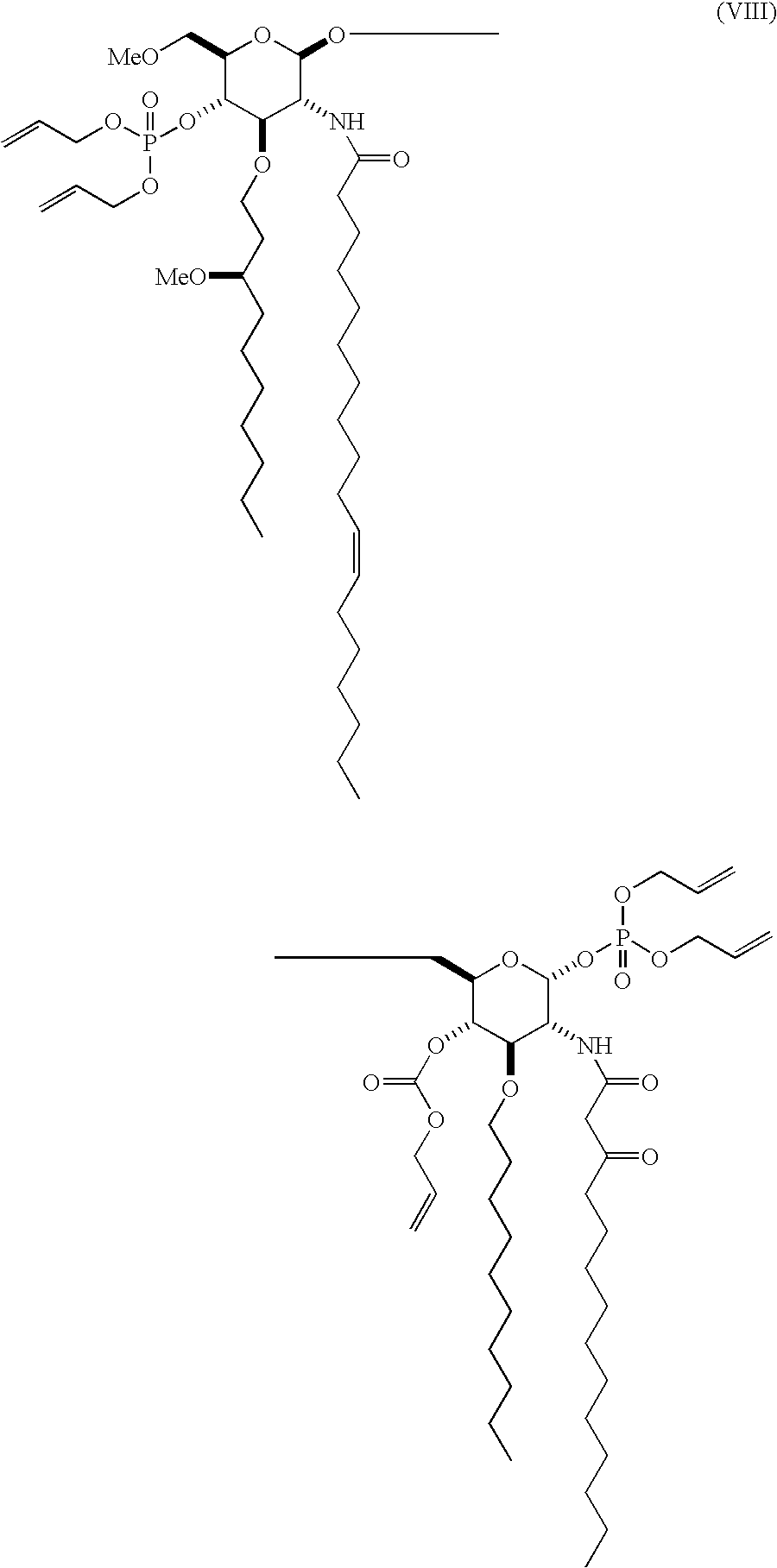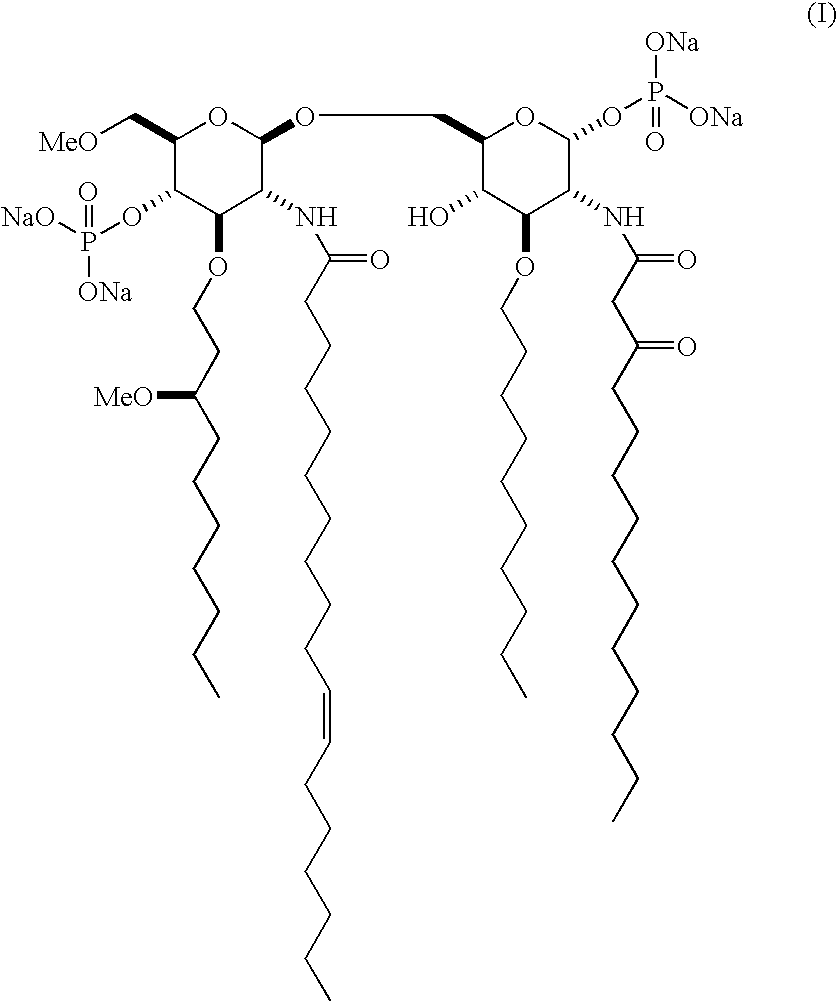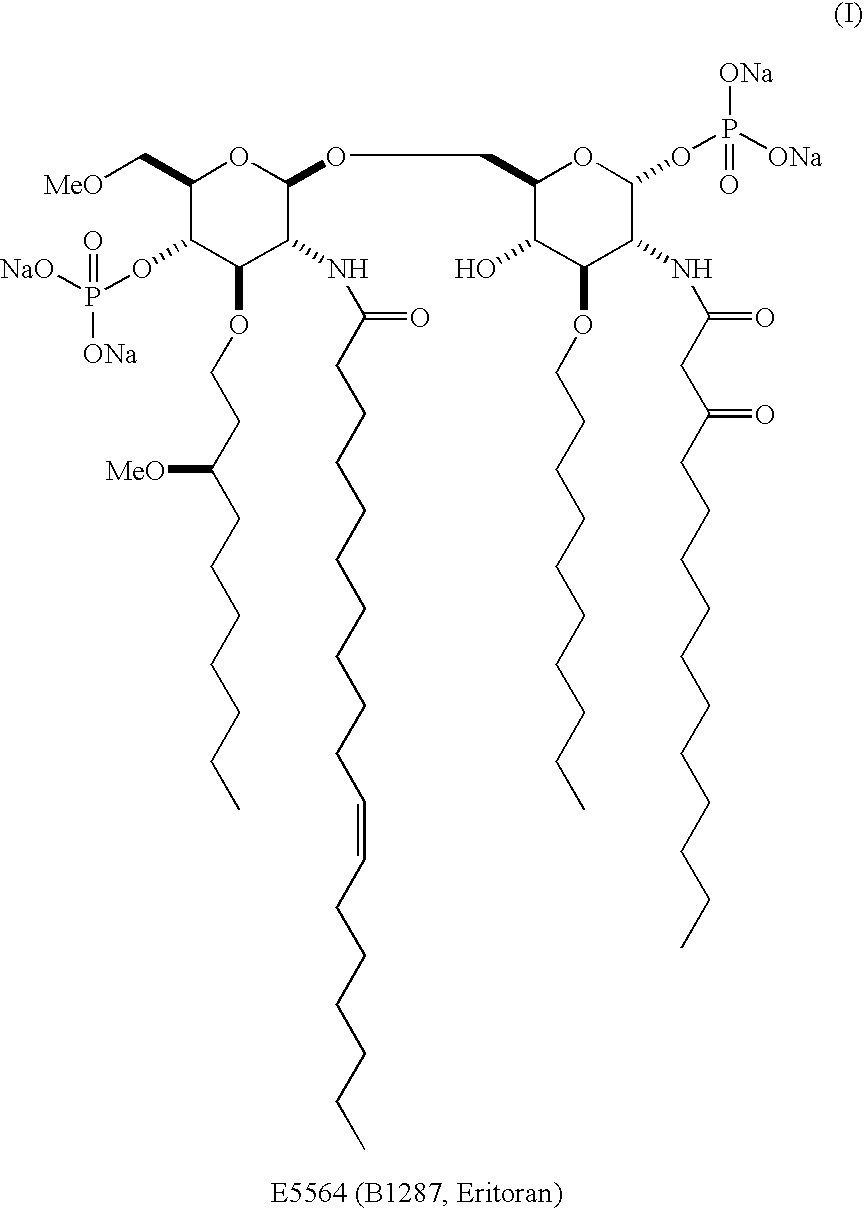Process for production of lipid a analogue
a technology of analogues and lipids, applied in the field of preparing lipid analogs, can solve the problems of low yield of remaining acyl-type side chains, and the inability to avoid the use of dichloromethane, and achieve excellent anti-endotoxin action, high fatality rate, and improved purity
- Summary
- Abstract
- Description
- Claims
- Application Information
AI Technical Summary
Benefits of technology
Problems solved by technology
Method used
Image
Examples
example 1
α-D-glucopyranose, (1Z)-1-propenyl 2-deoxy-3-O-[(3R)-3-methoxydecyl]-6-O-methyl-2-[[(11Z)-1-oxo-11-octadecenyl]amino]-, 4-(di-2-propenyl Phosphate)
[0116]
[0117]In a 2 L four-necked flask, 235 g of α-D-glucose, (1Z)-1 propenyl 2-deoxy-3-O-[(3R)-3 methoxydecyl]-6-O-methyl-2-[[(11Z)-1-oxo-11-octadecenyl]amino]-[CAS registered number: 748165-17-5] was dissolved in 933 mL of toluene. Then, to the mixture, 129 mL of diallyl N,N-diisopropylphosphoramidate, 39.4 mL of pyridine and 36.3 mL of trifluoroacetic acid were added dropwise sequentially at room temperature. After 1.5 hours of completion of adding, the reaction solution was cooled down to −20° C., and an acetonitrile diluted solution (933 mL) containing 47.5 mL of hydrogen peroxide was added dropwise over 37 minutes. After completion of adding, the temperature was raised up to 10° C. over a period of 40 minutes. After 3 hours, 940 mL of a 5% sodium hydrogen sulfite aqueous solution was added to quench the reaction, and the temperature...
example 2
α-D-glucose, 2-deoxy-3-O-[(3R)-3-methoxydecyl]-6-O-methyl-2-[[(11Z)-1-oxo-11-octadecenyl]amino]-, 4 (di-2-propenyl Phosphate)
[0118]
[0119]The solution of α-D-glucopyranose, (1Z)-1 propenyl 2-deoxy-3-O-[(3R)-3-methoxydecyl]-6-O-methyl-2-[[(11Z)-1-oxo-11-octadecenyl]amino]-, 4-(di-2 propenyl phosphate), obtained in Example 1, was washed with 699 mL of 1 N hydrochloric acid. To the resultant, 27.9 mL of 5 N hydrochloric acid was added, and the solution was stirred at room temperature for 5 hours. The solution was neutralized with 699 mL of 5% sodium bicarbonate aqueous solution, then, separated with ethyl acetate. An organic layer was washed with 699 mL of 5% saline. To the resultant, 69.9 g of anhydrous magnesium sulfate was added for drying and filtrated. The filtrate was concentrated under reduced pressure. To the residue was added 466 mL of acetone, and concentrated again under reduced pressure. The acetone treatment was repeated to obtain 289.1 g of a crude material of the titled c...
example 3
α-D-glucopyranose, 2 deoxy-3-O-[(3R)-3-methoxydecyl]-6-O-methyl-2-[[11Z)-1-oxo-11-octadecenyl]amino], 4-(di-2-propenyl Phosphate) 1-(2,2,2-trichloroethaneimidate)
[0122]
[0123]Into a 2 L four-necked flask was added 280 g of α-D-glucose, 2-deoxy-3-O-[(3R)-3-methoxydecyl]-6-O-methyl-2-[[(11Z)-1-oxo-11-octadecenyl]amino]-, 4-(di-2-propenyl phosphate), 46.8 g of potassium carbonate, 560 mL of methyl acetate, 170 mL of trichloroacetonitrile and 8.4 mL of water. The mixture was stirred for 2 hours at 0° C. under a nitrogen atmosphere. The reaction solution was filtrated through celite and concentrated at 40° C. under reduced pressure. Subsequently, azeotropy was performed 3 times with 560 mL of heptane, to obtain 432 g of the titled compound (content ratio: 63.9%, containing 171.4 mL of heptane). Yield: 87.5%.
PUM
| Property | Measurement | Unit |
|---|---|---|
| temperature | aaaaa | aaaaa |
| reaction time | aaaaa | aaaaa |
| reaction time | aaaaa | aaaaa |
Abstract
Description
Claims
Application Information
 Login to View More
Login to View More - R&D
- Intellectual Property
- Life Sciences
- Materials
- Tech Scout
- Unparalleled Data Quality
- Higher Quality Content
- 60% Fewer Hallucinations
Browse by: Latest US Patents, China's latest patents, Technical Efficacy Thesaurus, Application Domain, Technology Topic, Popular Technical Reports.
© 2025 PatSnap. All rights reserved.Legal|Privacy policy|Modern Slavery Act Transparency Statement|Sitemap|About US| Contact US: help@patsnap.com



